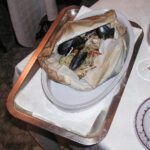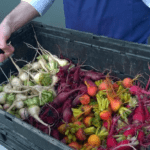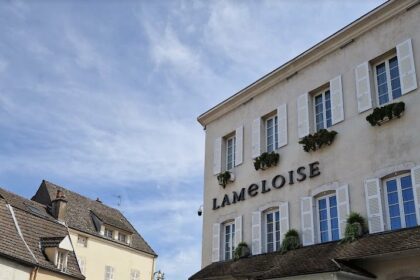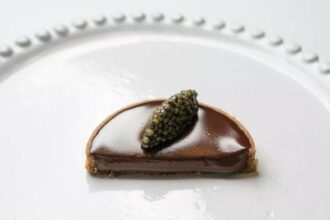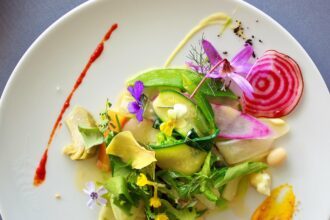When in Campania I usually lose track of time and space wondering if the sirens are actually echoing in my head. The environment is surreal. This time, about a month ago, I was invited to an event which also sounded surreal. My friend Enzo Caldarelli brought together the icons of the “New Spanish Cuisine” who cooked for two days (June 12 and 13) before a select group of journalists, friends, and sponsors of the event. This extraordinary event took place in Michelin two star Don Alfonso Restaurant in Sorrento whose chef and owner Alfonso Iaccarino and his elegant wife Livia turned out to be most hospitable, generous and engaging hosts. The participants in the event included Albert Adrià of elBulli, Andoni Luis Aduriz of Mugaritz, Alain Passard of L’Arpège, Pedro Subijana of Akelaré, Santi Santamaria of Can Fabes, Martin Berasategui of the eponymous restaurant, Joan Roca of El Celler de Can Roca, Claude Bosi of Hibiscus, and Oriol Balaguer. Chefs, such as Heston Blumenthal, Gianfranco Vissani, and, probably my favorite under 30 years old chef in the world, Fabio Barbaglini of Café Groppi in Trecate, were among the guests.
Although the main purpose of the meeting was gastronomical, the event also proved to be a great opportunity to renew friendships and to make new friends. Now that I come to think of it with the benefit of hindsight, a few things strike me:
First and foremost, I was amazed to see that how all these chefs, who are normally competitors, cooked together and developed cordial and friendly relations with one another and with the guests. The whole atmosphere created by the organizers did foster the development of durable ties.
Second, a great deal of attention was paid to details to maximize aesthetic pleasure. That is, from the selection of the state of the art tableware, to the design of individual menus and the presence of gorgeous models in teeny tiny bikinis who presented the menus, every single detail appealed to the eye and whetted appetite. I should say that Enzo has a style and a sense of humour which is unmistakably Italian even though his gastronomical bias is towards the new Spain.
Last but not least, the invited chefs did have access to the state of the art cooking materials and kitchen space, and some of them, such as Aduriz, showed up at the event with his full team, including his contact person for the English speaking world, Susanna, who is a most gentle and thoughtful person.
On my part, I arrived at the event a day before, on Saturday. I stayed in Napoli for one night to meet with my friends and dining companions Alberto Torres and Lydia Itoi. We know each other since the Stanford days, and Alberto is now the CEO of Vertu, the cell phone which he himself can hardly afford! Vertu was one of the sponsors of the event. Both Alberto and his stylish wife, Lydia, who also writes about food with knowledge and humor, are incredibly serious eaters. We seem to agree with each other 90% of the time, and such a consensus is rare in our small world of gourmets. Actually I should say that sometimes we get bored agreeing with one another and explore differences as we all like to be provocative. As for one note of caution though, Alberto, who looks and behaves like a well groomed person, gets transformed when he is commanding the wheel. It turns out that his alter ego is a Formula One racer. I still have the vision of the handsome face of Jordi Rabat, Alberto’s friend and distributor in Barcelona, with his eyes expressing horror and one hand desperately clinging to the handle in the back seat of the car, while Alberto was experimenting with how fast one can turn on the very windy parts of the road between Sorrento and Sant’Agata.
We had four meals with Lydia and Alberto before the beginning of the great event. On Sunday night we started with the pizzas of the great master Ernesto Cacialli. His pizzeria in Napoli is called Pizzeria del Presidente, and together with Pizzeria di Matteo, he concocts some of the best pizzas in Napoli, or shall we say, in the world. Actually he is a friend of Enzo too, and it was his pizzas that kick started the Stravaganza Mediterranea on Monday afternoon. One has to taste his pizzas, and also his pizza fritta (with pork crackling in addition to classical ingredients) to understand how good pizza can get, as words can’t describe the childish joy we all took in slurping large bites after folding the pizza like a handkerchief and holding it with a napkin. Ingredients are top, but the real beauty of it is the fresh dough. They have to be consumed immediately when they come sizzling hot from the wood fired stone oven. Only a refined and genuinely friendly French person, whose name is Alain Passard, used a knife and a fork, but he was shown the right way of eating true Neapolitan pizza by Lydia.
We followed our pizza feast with a seafood feast at Restaurante Dora in Napoli whose deep water whole grilled and super fresh pezzogna and big scampis left indelible marks in our memory. When in Napoli don’t miss it. I should add that Napoli is a city with great character, and after Istanbul I found Napoli to be relatively calm and manageable in size. Next time, I have decided to spend more time and explore the museums and more pizzas, of course.
On Sunday we had two memorable meals: Nonna Rosa in Vico Equense and Don Alfonso. The former was a special recommendation from Enzo, and both Lydia and Alberto had been there before. This is a very genuine and creative trattoria, where the chef-owner Peppe, who resembles a provincial governor during Roman times, cooks super pastas and perhaps the world’s best Melanzane di Parmigiana. Pristine and local ingredients are assembled together with flair and clarity expressing individual taste. I am still craving his fiori di zucca sitting on top of a thin crouton and stuffed with sweet melanzane puree and surrounded by a coulis of San Marzano tomatoes, basil and fonduto of scamarzo cheese. I am also craving some local specialties we tasted at Don Alfonso the same night: especially the ricotta balls with nettle in a fish consommé and a gateau of potato stuffed with local mozzarella and pancetta. The former dish reminded us of quenelles at their best in consistency, and the ricotta balls were encased in what we thought to be thin pasta but turned out to be egg white. Like the ricotta, the quality of the potatoes was also unbelievable, and Iaccarino’s gateau resembles a soufflé, although he does not use cream or butter in this dish.
The event for which we had come was in full swing by Monday night. Because myself or my Gastroville partner (then) Mikael Jonsson have already analyzed all but a few of the chefs in our reviews, I have little to add in substance. The most interesting thing for me was to perceive the coexistence of several styles and to realize that the categories we concoct (such as New Spanish) are actually quite misleading as the chefs we group together represent very distinct traditions and styles which have little in common. The opening salvo consisted of a series of tidbits prepared by Albert Adria and the elBulli staff. It seemed to me that Albert is even more fond of the so called morphings than his brother Ferran. Actually, if Albert’s offerings are a guide, one should call Ferran Adria a relatively traditional chef. There was nothing even remotely approaching the food eaten in this earth by Albert, and, thus, his offerings are never “boring”. I especially liked croquant of mango with Szechuan pepper, but, above all, his equally croquant chips enriched by powder from prawn shells and colored by squid ink must be tasted to be believed.
It is hard to follow a virtuoso performance, such as Adria’s, but Aduriz managed to titillate our palates with unusual flavors and aromas. His opening salvo was also most daring and unusual: a superb salad of cooked and raw vegetables with emmenthal sauce. I had already raved about it in my review here, and this time I was equally thrilled by the indescribably “piquant” flower from Brazil called “Espilantes Acmella.” The aftertaste lingers so long and is so strong that no wine consumed in this world can actually match it. At any rate, no wine was served during the formal dinners in the main dining room, and Aduriz beautifully matched aromatic infusions with his courses. Next time I will lower my cost in Mugaritz by ordering infusions rather than wine, which, if good, risk to steal the show, and this is clearly disrespectful for the chef. At any rate, Aduriz seems to be opting for a more cerebral and esoteric approach to cooking. If my predictions are correct, he will shy away from serving some of his classics, such as foie gras dishes and the French Toast dessert in the future.
Unfortunately Alain Passard was the last to cook on Monday night, and his dishes started to arrive on our table in the wee hours of the night. Enzo, rightly told him not to cook his famous egg which would have been too much. But as soon as Passard’s food hit the table the mood at our table changed as even the simplest preparations by Passard, such as seasonal vegetables such as fava beans and carrots in a radish ravioli and bound together by olive oil emulsion, demand attention. It is easy enough to learn that he uses lemon and honey in the emulsion, but the difficulty here is to establish the right harmony and balance. Passard’s dishes are light and satisfactory at the same time. They show impeccable technique geared to enhance and not substitute for taste. I still recall that Fabio Barbaglini, whom I called my favorite young chef in the Western world, ceased to converse with us to fully concentrate when the Passard show started. He was especially fond of the caramelized leek and smoked potato dish with muscade powder. Personally I can eat Passard’s “millefeuille” every single day.

We slept through the breakfast the next day, which featured Oriol Balaguer. Alberto and I then tried to reignite our appetite by diving into the still cold waters of the Sorrento coast before “flying back” to Sorrento with Alberto and Lydia. What we found there was that Santi Santamaria was only allowing four people to sit at a time at the counter when they would be privileged to taste his tapas cooked sur mesure. At the same time the “Subijana” show was about to unfold. While I was watching Alberto, Lydia, Alfonso, and Livia devouring the appetizing tapas, I must have looked like a hungry dog watching other dogs feasting on large bones as Enzo pulled me inside to witness the Subijana show that was about to start. And what a show it was! The Subijana dishes dazzle and astonish. All Italians in my table for instance were taken aback by what looked like a mozzarella soufflé and turned out to be a hollow balloon of mozzarella dusted by tomatoes hiding below some bubbles (squid ink “caviar”) and squid. I am sure Beppe of Nonna Rosa was taking notice of how to garner Michelin stars. Because Subijana dishes represent the application of avantgarde techniques and cooking instruments to modern cuisine, his preparations were also televised in the room on giant screens. His last preparation of a lobster dish where he uses two coffee filters to “distill” its juice before blending it with herbs was both fun to watch and a delight to taste.
I was hoping to rush back to the garden in order to find a space at the Santamaria table. Everybody else must have thought and done the same. Securing a place at the counter proved as hard as securing a reservation at elBulli. It demands persistence, speed, shameless manoeuvres, and a lucky break. At any rate, it was worth it. Santamaria simply cooked traditional tapas a la plancha, such as bacalao tripe (with almond slivers and beans) or gelatinous pork jaw with caramelized onions. They were all good, very good and, excellent. Furthermore, wine was served. This was true bliss. Next time in the area I will visit Can Fabes, but only if Santamaria is in the kitchen. But as a note of caution, this man is the antithesis of avantgarde Spanish cuisine, in the sense that he is crazy about sourcing ingredients and he reinterprets classical dishes instead of “creating” dishes. So for those who laud elBulli, this may not be the right address.
Following a break of four hours or so during which we returned to our hotel and rested, the evening feast started. It featured the cooking of Claude Bosi, Joan Roca, and Martin Berasategui. It was also very well coordinated, as there was a sense of progression and order in the flow. That is, instead of one chef cooking all the dishes before the next one set out to cook, the three chefs took turns to cook. Therefore they were able to progress from lighter to more substantial dishes. This format also enabled us to compare different styles.
One thing I learned from this format is that it is not possible to reach a consensus in the world of gourmets. Take a mackerel dish, served with rhubarb and rabbit ravioli by Bosi, as an example. Lydia told me that this dish is inspired by the Fat Duck‘s Sardines. I have not tasted the Fat Duck version, but this dish, too, like many Adria preparations, had to be tasted to be believed. Personally I could not believe that Spanish Mackerel, one of my favorite fishes, can metamorphose into such a texture and taste. But reasonable minds differ. Some people lauded the dish and Claude Bosi, whereas others, I should add especially the French (and Bosi is French), missed the point and refused to take a second bite.
Both Berasategui and Roca are forces to reckon with in the culinary world. Personally I had had two great and one very good meal at Can Roca. I find Joan to be a master of harmony, and he has an unmistakeable style in the sense that he always introduces a contrasting element to his dishes which renders the dishes more complex. Desserts, on the other hand, can range from super to kitch. This time, probably because Joan came only with one assistant, his dishes did not display the full range of flavors of which he is capable. I hope he garners the three Michelin stars he deserves. I also hope that he talks to Jordi about not rendering the new dessert creations to be too fussy and complicated.
My partner Mikael has recently reviewed Berasategui. My own experience in his restaurant is similar since he garnered the third star, but I was more thrilled by his cooking in the late ‘90s when he had two stars. This is a guy who knows Basque cooking and, in the ‘90s, his take on the traditional cuisine was always noteworthy. I do not think he was too comfortable cooking in Campania, where at least one dish he had to substitute squid for the requisite percebes. His daring play on temperature and texture in the potentially superb dish of octopus reviewed by Mikael may also have suffered due to conditions outside his control. But his cooking reflects the passion and the enthusiasm which the man exudes.
Our fairy tale ended with a garden party and live music accompanied by some Don Alfonso dishes. Unfortunately none of us could do justice to them at this late hour, but all of us were truly appreciative of the hospitality and generosity bestowed upon us by the organizers of the event. Even though most participants and the cooks were non-Italian, a sense of “joie de vivre” and “solidarity” diffused to all of us through this surreal two days. This is much more important than comparing individual chefs and critiquing some dishes. Heartfelt thanks to Enzo for making all of this possible.

